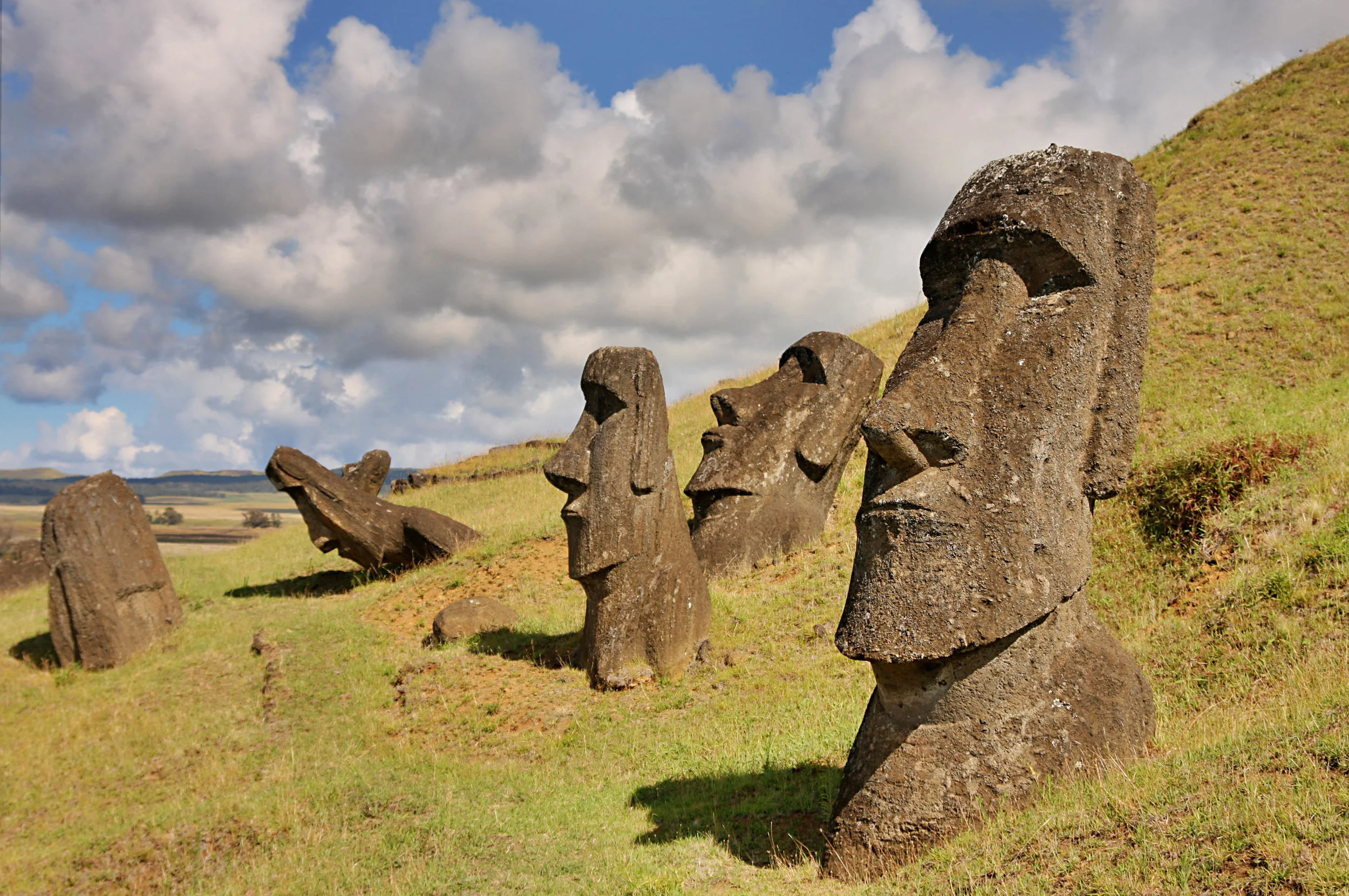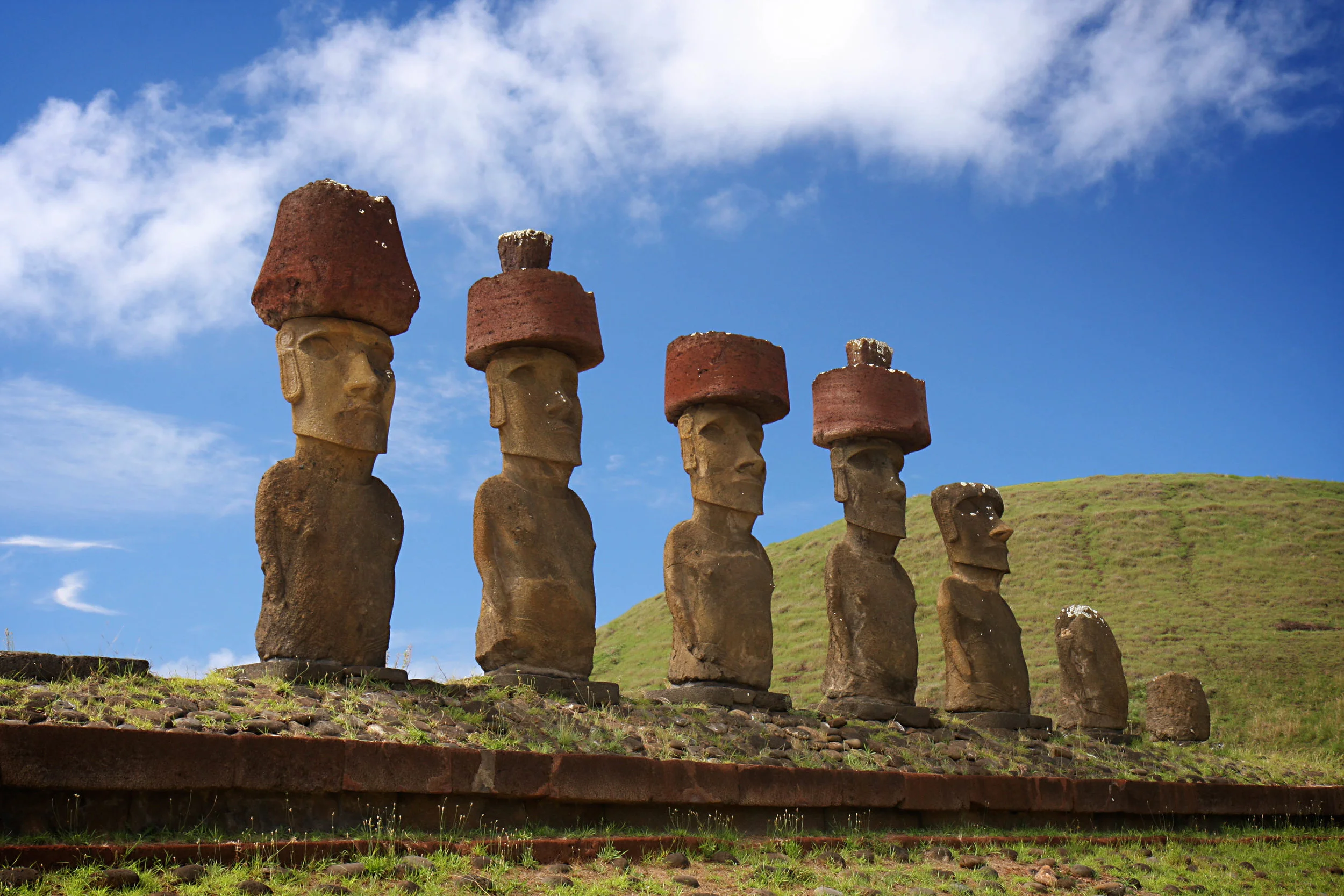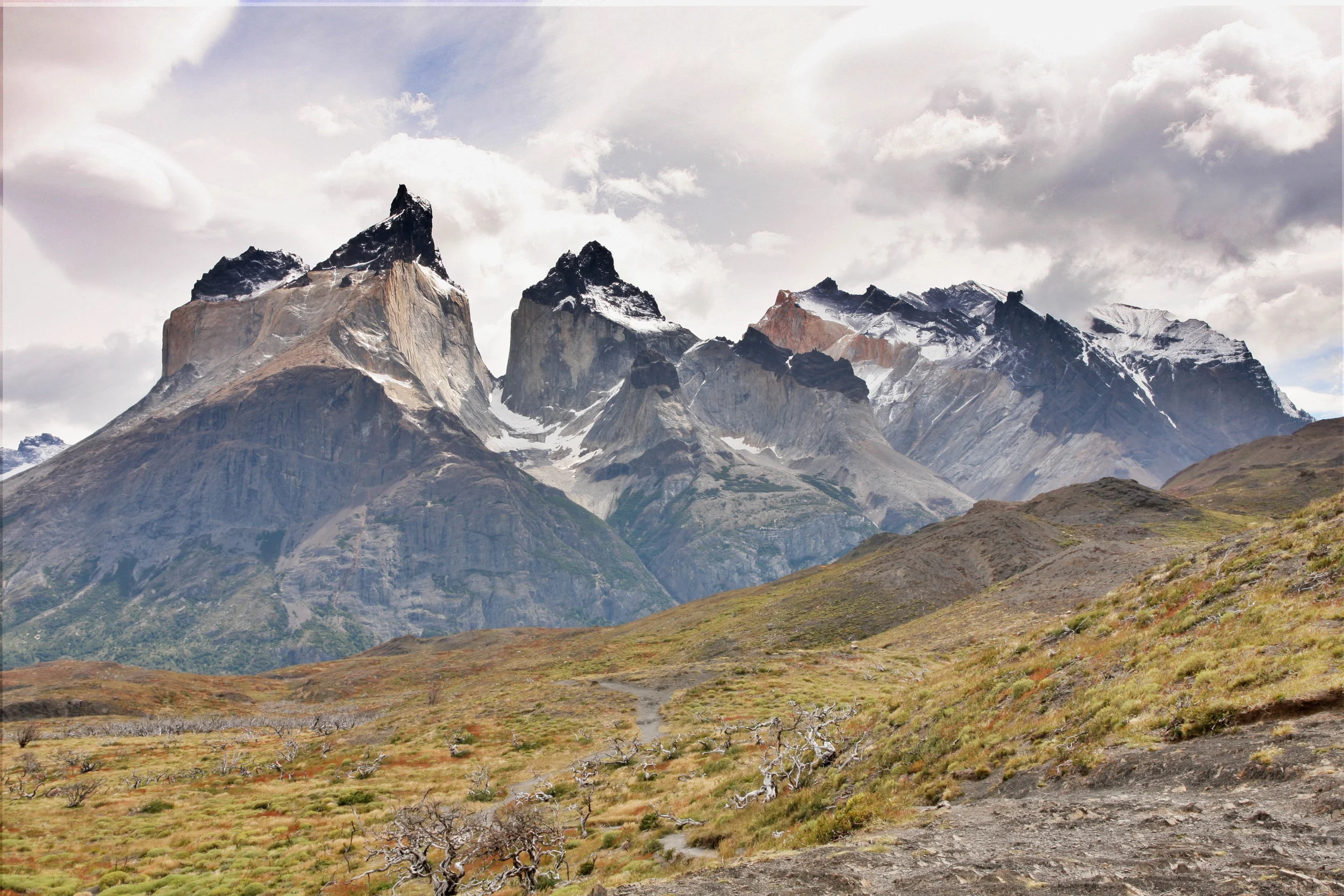easter island • isla de pascua •Rapa Nui
No matter what one may call the island, it’s sure to bring mysterious and surreal images to mind. Images of moai, the enormous stone heads/torsos that dot the landscape, oft recalled from childhood explorations through back issues of National Geographic magazines...
the outer flanks of the Rano Raraku quarry
Easter Island is a remote dot in the vast South Pacific - at just 7 by 15 miles, with the closest people over 1,000 miles distant, on even smaller Pitcairn Island - Chile and Tahiti are each over 2,200 miles distant, in opposite directions.
Early history of the island is likely to always remain a mystery. The first colonization occurred around 300-400ad, most likely from Polynesia (based on the physical characteristics of the people, their culture, religion, and language).
The population of the island thrived in the early years, reaching a peak of between 10,000-15,000 people. This was more than the small island could bear though. Eventually the ecosystem of the island was stretched to the point of complete deforestation, and a collapse of the society. Bloody civil war broke out between the different clans. The moai were toppled. Society was in ruins. The island’s population plummeted to near 3,000 in just a few years. The first European explorers to see the island (on Easter Sunday, 1722) report standing moai, and forests to be seen in the distant inland valleys. Captain Cook reported seeing neither just 52 years later when his ship called there.
At the society’s peak they accomplished truly amazing things. The moai, and there are nearly 1,000 of them, were carved from the tuff lava of one volcano, Rano Raraku. The red scoria top-knots for the moai were carved from a different volcano. Both parts were then transported tremendous distances to numerous locations scattered around the island, then erected. The Rapa Nui had the only written language, Rongorongo Script, in all of Oceania. Numerous elaborate petroglyphs were carved into the rocks around the island.
The island was ultimately “annexed” by Chile in 1888; Chile’s first, and only, attempt at colonization. This would prove to be another of the many trials the islanders have faced. Between slave raids and disease, the population on the island had dropped to 111 people by the start of the 20th century.
Today the island has both a governor and a mayor. There is also a council of elders who have a fairly strong field of influence. This council has one representative from each Rapa Nui family - 39 in all. There are close to 4,000 people living on the island, with about 2,000 of them being Rapa Nui. The remainder are mostly Chilean. It is estimated that another 1,500 Rapa Nui live in other parts of the world - mostly Tahiti, North America, Europe, and Chile (where many Rapa Nui teens attend school).
To this day one sees relatively few animals. Seasonally seabirds, including frigates, noddies, terns & petrels, nest on the surrounding motu (small islets). Some land birds, including chimango caracara, common Diuca-Finch & Chilean Partridge, are also in evidence. Snorkeling in the beautiful clear blue bays reveals few fish - the fishermen ply their trade several miles offshore where the currents produce a greater abundance.
But, one comes to Rapa Nui for the moai, the history, the culture and these will absolutely amaze!
Anakena is the site where the first settlers arrived
We offer two ways to experience Easter Island:
Fully escorted small-group touring
Roughly every-other-year we offer a small-group tour, for a maximum of 12 participants. The expedition typically includes 6 or 7 days on the island and is timed to coincide with the annual Tapati cultural festival in early February.
Semi-independent private touring
We are happy to create custom tours of any length, year round. We use the same great guest house and outstanding guides, and included the same island visitor sites (based on how long you opt to stay).
Our 2025 trip has just been finalized and is now open for bookings (16 guests maximum). Click below for the trip details.
Tahai at sunset
“Josie is an amazing guide and having her to myself only added to my magical experience.”
Frequently Asked Questions...
When should I go? Anytime! The climate on Rapa Nui is influenced by the ocean, so on the temperate side. Typical December-March daytime temperatures range from the upper 70’s to low 80’s; although humidity may be high, this is when the island sees the most visitors. Temperatures are cooler during the austral winter of June-September (average daytime temperatures are more typically in the 60's to low 70's). Rain showers are possible year-round.
How do I get there? The island is only serviced by one airline: LAN (formerly LAN Chile). Flights are several times a week from either Santiago, Chile, or Tahiti. Flight time is roughly 5 hours from Santiago. Once a week there is a flight from Tahiti, 2,200 miles to the west.
What are Chile's arrival & departure logistics? Chile recently waived the reciprocity entrance fee for U.S. passport holders (Canadians & Australians are still charged a fee). There are no visa requirements for U.S. Citizens, and there is no international departure tax. There is a Rapa Nui (Easter Island) National Park fee of $72.00 (not included in the trip price).
Is this a wildlife tour? Definitely not. Our focus is on the history and the culture. That's not to say that the hard-core birder can't rack up a number of new species though either. Over 6 days on Easter Island on an earlier trip we saw: Chimango Caracara, Common Diuca-Finch, Rock Dove, Great Frigate, Brown Noddy, Gray Noddy, Sooty Tern, Sooty Shearwater, House Sparrow, Chilean Tinamou, Herald Petrel, White-tailed Tropicbird, Grey-headed Bull, & Chilean Partridge.
Is this a luxury or deluxe tour? No - that's not the direction we wanted to go. Again, we're here for the history and the culture. The Aloha Nui is a wonderful B&B, or Latin American style residential. The family who run it are wonderful, and you will leave at the end of your trip feeling like you have been staying with family. You will come away with a true sense of the island and its people, and a bit of the magic of Rapa Nui.
Where should I eat when a meal is not included in the itinerary? There is a wide range of options, from kiosks selling empanadas and sodas and beer, to cafes "downtown," to the seaside French Restaurant that bills itself as the best French Restaurant in the Pacific. Your choices are many, and your guide will be happy to make recommendations to suit your tastes or mood.
What language is spoken on the island? The native language of the island is Rapanui, although Spanish is also very widely spoken. Most islanders working with tourists in some capacity will also speak at least some English. Whatever the language, everyone is universally friendly so you should have no problem communicating. All guiding is in English.
What is there to do on the island if I have a "free day" in my itinerary? Lots - and the best part is, the island is so small it would be hard to get lost! You could easily rent a car or jeep for the day to either revisit a favorite site (or beach), or explore new territory - maybe drive out to Tongariki to watch the sun rise behind the moai! Bikes are also rented in town if you're looking for some exercise with your adventure. Also, the only ways to visit the roughly one-third of the island's coastline without a road is either by hiking or renting horses (the horse trip, with a cowboy/guide is a great way to see it!). You can also stroll the streets of town, visit the artisan's market, go diving, take surf lessons, go to the museum, or just relax and take in being on Rapa Nui! A 25 minute stroll from the Aloha Nui brings you to the best show on the island - the lavish tropical sunsets as seen through the moai at Tahai.
What about money matters? There is no need to change currency before arriving in Chile - the U.S. Dollar is widely accepted - their local currency is the Chilean Peso. There are both exchange booths and ATM machines in the Santiago Airport. Major Credit Cards are commonly accepted in most parts of Chile. Traveler’s checks are easily exchanged in Santiago, but may be difficult to exchange outside the city. Rapa Nui now has three ATM machines as well, although it is best to plan on bringing enough cash, and/or traveler’s checks with you to the island.
Tipping is common practice in hotels and restaurants in Chile. A 10% tip is customary in restaurants and cafés, while a dollar or a few pesos is adequate to porters. Guidelines for tipping on Rapa Nui are roughly $10-15 per day, although, as always, all gratuities are discretionary.
What is the Tapati festival? Once a year, in early February, the islanders throw a 2 week party for themselves. The festival promotes Rapa Nui ancestral customs through song, dance, typical dress, arts, athletic competitions and ancient traditions.
What else to you offer in Chile? We're really focused on Easter Island, and all that it has to offer. However, Chile, with its hundreds of miles of coastline, soaring mountains, deserts, lakes and glaciers, has much to offer as well. Working with a local tour company we have multi-day options in either the Northern Deserts around San Pedro de Atacama, or in Chilean Patagonia and the Torres del Paine National Park in the far south.
Torres del Paine




